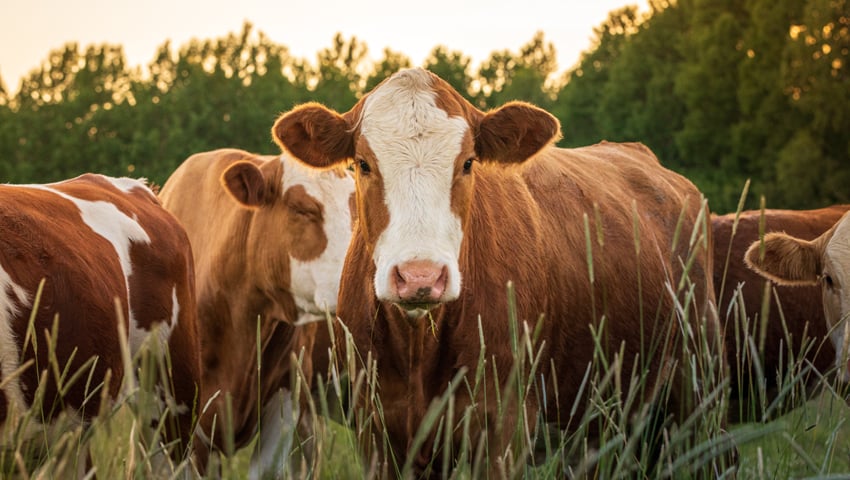A US STUDY shows that when using GWP* to assess the global warming impact of agricultural methane, the enteric emissions from US ruminants delivered a negligible or cooling contribution between 2010 and 2020, while methane emissions from slurry (particularly associated with indoor dairy and pig systems) had the opposite effect.
GWP* is the Intergovernmental Panel on Climate Change-approved metric that can be used to more accurately assess the global warming impact of methane (CH4). This contrasts with the standard metric, GWP100, which has long been known to mischaracterise the behaviour of short-lived gases, such as methane, because it treats all greenhouse gases as though they behave in the same way as the long-lived CO2.
The research applied the GWP* methodology to both enteric CH4 (produced by microbial fermentation in the rumen) and CH4 emissions from manure. They found that enteric methane emissions were largely stable or reducing, while increases in CH4 emissions from manure were largely driven by the dairy and pig sectors and the increase in the use of wet manure/slurry systems.
The research paper’s authors – Matthew R. Beck, Logan R. Thompson, Jason E. Rowntree, Terra N. Thompson, Jacek A. Koziel, Sara E. Place and Kim R. Stackhouse-Lawson – said, “To date, the implications of using GWP* rather than GWP100 have not been discussed for manure emissions and have not been discussed for enteric and manure emissions relative to different livestock species or geographical regions of the United States.”
The authors found once again that metrics matter. The accurate GWP* metric showed that wet manure was a larger contributor to climate warming than enteric CH4 between 2010 and 2020. This stands in contrast, they said, to the GWP100 methodology, which suggests that enteric CH4 emissions over the same period were on average 206% greater contributors to warming than manure CH4 emissions.
Enteric methane
The researchers found that, “Changes in estimated CH4 emission rates resulted in net cooling effects for several years when using GWP* to estimate climate impacts.” However this was specifically related to changes in cattle numbers. “Reductions in cattle numbers occurred from 1990 to 2005 for dairy cattle and from 1995 to 2014 for beef cattle.”
Applying GWP* to national enteric CH4 emissions reduced its cumulative implied contribution to climate warming during 2010–2020 by 74% compared with the GWP100 method. This effect was due to the changes in enteric CH4 emission rates during that timeframe, which were mainly caused by changing cattle inventory.
The authors commented that these herd reductions related primarily to drought, farms going out of business and to disease. They noted that “While reducing enteric CH4 emissions is an important goal, we should not strive to achieve it through cattle inventory reductions alone. Reducing cattle populations would have a multitude of negative impacts. This includes negative economic impacts on rural economies that rely on ruminant agriculture, worsened food security via increasing food prices for high-quality food, and directly harming the emotional, cultural, and economic realities of those who rear these animals.”
Manure methane
The researchers write that “In contrast with enteric CH4, when GWP* is applied to manure CH4 emissions, it provides considerably higher implied climate warming estimates (on a CO2 basis).
“Using GWP* with manure CH4 resulted in cumulative CO2-we values from 2010 to 2020 that were 46% higher than the CO2-e values obtained when using GWP100.
“This was due to a near-linear increase in manure CH4 emissions from 1990 to 2020, which was driven by dairies adopting more liquid storage of manure. In fact, when using GWP*, the cumulative implied climate warming effects of manure CH4 from 2010 to 2020 were 85% greater than for enteric CH4 emissions.
“This suggests that manure CH4 has contributed much more to climate warming than enteric CH4 over this timeframe. The results of this modelling experiment call for rapid reductions in manure CH4 that are needed to occur, which is possible with liquid-stored manure by installing anaerobic digesters.
The researchers said, “According to the EPA dataset, manure CH4 emissions have been increasing at a drastic and consistent rate from 1990 to 2020. These increases are largely driven by dairy and swine production. Manure CH4 originates from anaerobic microbial fermentation of organic matter, and as such, the largest sources of manure CH4 occur in confined animal systems where manure storage occurs in wet, anaerobic conditions.
“Manures from dairy and swine are increasingly stored in liquid-based systems via retention ponds, lagoons, and pits underneath pen floors. This shift in manure management is a key driver behind manure CH4 emission increases for swine and dairy production.
“Furthermore, as the dairy industry became more and more consolidated with a diminishing number of small farms (< 500-head) and an increasing number of larger farms (>500-head), there was an increasing number of dairy farms handling their manure in liquid form.
“This greatly corresponds with the drastic increases in manure CH4 emissions from the dairy industry. From 2003 to 2014, the proportion of farms using liquid slurry manure management increased by 9.7%, and the proportion of farms using anaerobic lagoon manure management increased by 16.9%.”
The researchers concluded that “Implementing GWP* calculations for enteric and manure CH4 emissions has enormous effects on the implied climate warming contribution of these sources of emissions.” Therefore, they said, “its adoption by reporting bodies, such as the EPA, is necessary to adequately inform policy decisions that aim to reduce global warming.”
